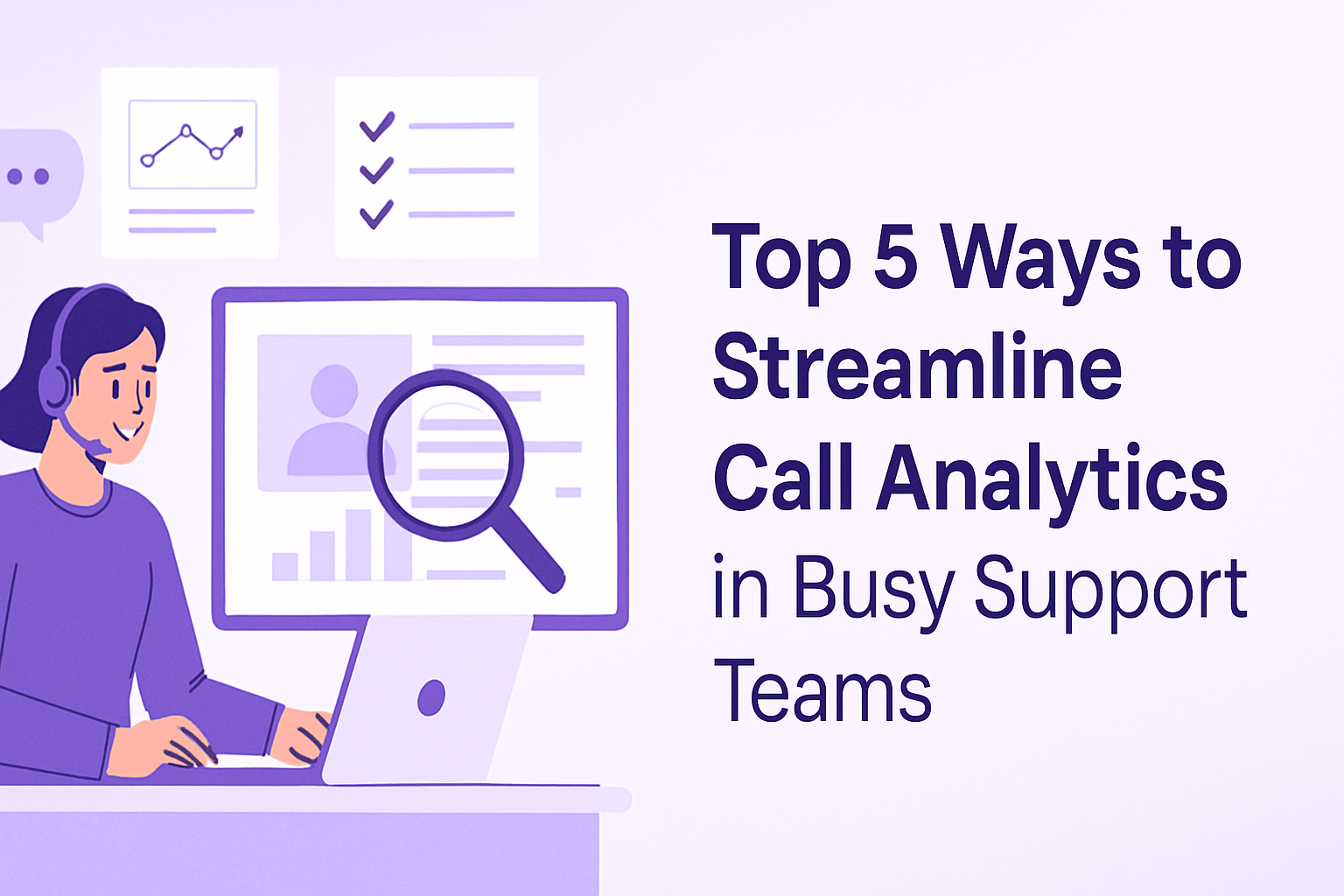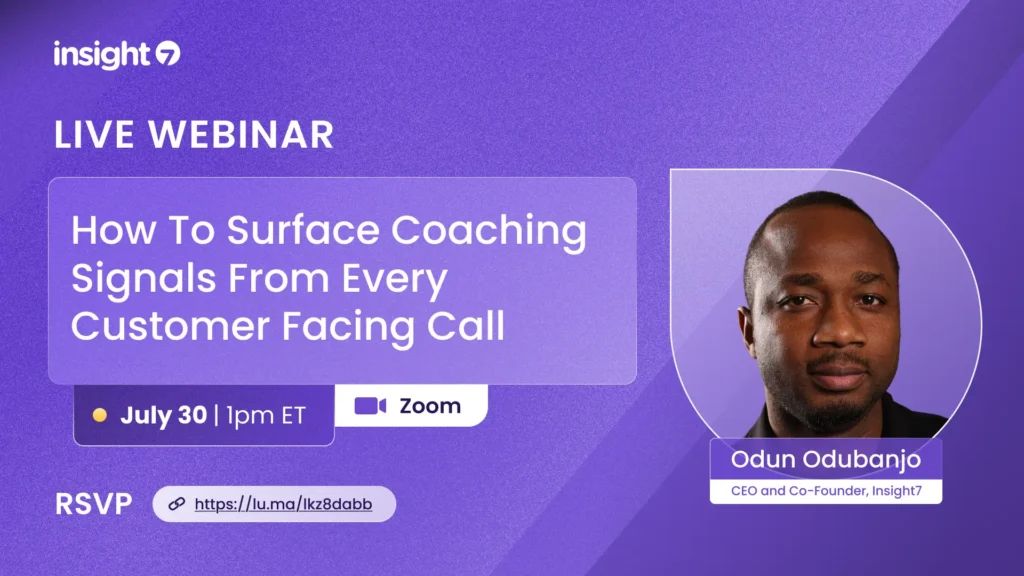The Best AI Call Analytics Tools for Multilingual and Global Teams
-
Hello Insight
- 10 min read
The Best AI Call Analytics Tools for Multilingual and Global Teams
Navigating the complexities of customer interactions in a multilingual and global landscape can be daunting for businesses. The right AI call analytics tools not only streamline communication but also enhance the customer experience by providing actionable insights. In this guide, we will explore the most effective AI call analytics tools for multilingual and global teams, highlighting their key benefits and implementation strategies.
The Role of AI Call Analytics in Modern Business
AI call analytics has become essential for organizations aiming to improve customer interactions and operational efficiency. By leveraging advanced technologies, businesses can transform raw call data into valuable insights that drive decision-making. Traditional methods often involve manual data analysis, which can be time-consuming and prone to error. In contrast, AI-driven solutions automate the analysis process, allowing teams to focus on strategic initiatives rather than data crunching.
This shift from reactive to proactive analysis not only enhances operational efficiency but also fosters alignment across different teams. For organizations with diverse linguistic needs, AI call analytics tools can facilitate seamless communication and ensure that all customer voices are heard.
What is AI Call Analytics?
AI call analytics refers to the use of artificial intelligence technologies to analyze phone interactions and extract meaningful insights. Unlike traditional call monitoring, which often focuses on basic metrics like call duration or volume, AI-driven tools offer deeper insights into customer sentiment, agent performance, and call quality.
Core Capabilities:
- Sentiment Analysis: Automatically evaluates customer emotions during interactions, allowing teams to identify potential issues early.
- Performance Scoring: Grades agent performance based on various criteria, helping identify training needs and areas for improvement.
- Keyword Tracking: Monitors specific phrases or terms to gauge customer interest and satisfaction.
- Call Summarization: Provides concise overviews of conversations, streamlining the follow-up process for agents.
- Reporting and Dashboards: Visualizes data insights to facilitate quick decision-making and strategic planning.
Strategic Value: By integrating AI call analytics, organizations can enable proactive decision-making and enhance overall alignment across functions.
Why Are Consultants and Insight-Seeking Professionals Investing in AI Call Analytics?
As organizations evolve, traditional approaches to call analytics are increasingly viewed as insufficient. The push for enhanced customer experiences and operational efficiency drives the adoption of AI call analytics tools.
Key Drivers:
- Data Silos: Many businesses struggle with fragmented data across various channels, making it difficult to gain a holistic view of customer interactions.
- Need for Speed: In the fast-paced business environment, timely access to insights can make a significant difference in customer satisfaction and retention.
- Personalization: Customers expect tailored experiences. AI call analytics tools enable organizations to personalize interactions based on data-driven insights.
- Operational Optimization: With comprehensive analytics, teams can identify inefficiencies and make informed decisions about resource allocation.
What Data Powers AI Call Analytics?
A robust AI call analytics system relies on various data sources to create accurate and actionable insights.
Data Sources:
- Call Transcripts: Textual representation of calls for detailed analysis.
- CRM Systems: Customer interaction history to enhance context.
- Feedback Loops: Customer satisfaction surveys and feedback mechanisms.
- Multilingual Data: Data from diverse linguistic sources to ensure comprehensive analysis.
- Integration with Other Platforms: Such as Salesforce, Gong, and HubSpot for enriched insights.
Accuracy Benefit: By employing a multi-modal approach, businesses can enhance the accuracy of their insights, leading to better decision-making.
Key Components of an AI Call Analytics Stack
Stack Overview: A successful AI call analytics stack integrates multiple components that work together to process and analyze call data efficiently.
Component Descriptions:
- Data Ingestion: Collects call data from various sources, ensuring comprehensive coverage.
- Natural Language Processing (NLP): Analyzes spoken language to derive sentiment and key themes.
- Analytics Engine: Processes data to identify patterns and generate insights.
- Reporting Dashboard: Presents insights in an easily digestible format for stakeholders.
- Feedback Mechanism: Allows for continuous improvement based on insights gathered.
Quality Emphasis: The effectiveness of an AI call analytics system hinges not just on the data collected but also on the quality and interpretability of the insights generated.
How Does AI Call Analytics Work Step by Step?
Step 1: Data Collection
AI call analytics begins with the collection of call data from various sources, including phone systems, CRM platforms, and customer feedback tools.
Step 2: Data Processing
The collected data undergoes processing, where it is transformed into a format suitable for analysis. This includes transcription and sentiment scoring.
Step 3: Analysis
Advanced algorithms analyze the data to identify patterns and insights. This can include:
- Trend Identification: Recognizing common customer queries or complaints.
- Performance Evaluation: Assessing agent performance based on specific metrics.
Step 4: Learning
The system utilizes historical data to improve its predictive capabilities, learning from past interactions to enhance future analysis.
Step 5: Real-Time Processing
AI call analytics tools often offer real-time processing capabilities, allowing teams to receive immediate feedback during customer interactions.
Step 6: Insights Delivery
Finally, actionable insights are delivered through customized reports and dashboards, enabling stakeholders to make informed decisions.
- Example output 1: Customer sentiment trends over time.
- Example output 2: Agent performance scores.
- Example output 3: Common keywords and phrases used by customers.
Where Can Consultants and Insight-Seeking Professionals Apply AI Call Analytics?
Use Case 1: Customer Support Optimization
- Prediction Method: Analyzing past call data for common inquiries.
- Recommended Action: Adjusting training programs based on identified knowledge gaps.
Use Case 2: Sales Performance Improvement
- Analysis Approach: Evaluating sales calls for effectiveness.
- Follow-Up Action: Providing targeted coaching based on performance data.
Use Case 3: Multilingual Support Enhancement
- Identification Method: Assessing sentiment across different languages.
- Proactive Scheduling: Ensuring language-specific support is available during peak times.
What Tools Can You Use for AI Call Analytics?
When selecting an AI call analytics tool, consider features that cater to multilingual needs and global operations.
Comparison Table:
| Feature | Insight7 | Traditional Alternatives |
|---|---|---|
| Multilingual Support | Yes | Limited |
| Real-Time Analytics | Yes | No |
| Sentiment Analysis | Yes | Basic |
| Integration Capabilities | Extensive | Limited |
| Custom Reporting | Yes | Basic |
Common Pitfalls in AI Call Analytics Implementation
Context Warning: Many organizations face challenges when implementing AI call analytics, which can hinder effective use.
Major Pitfalls:
- Lack of Stakeholder Alignment: Without buy-in from all teams, implementation can fail.
- Inadequate Data Quality: Poor data quality leads to unreliable insights.
- Neglecting User Training: Users must be trained on how to interpret and act on insights effectively.
- Integration Challenges: Failing to integrate with existing systems can limit functionality.
How Do You Get Started with Insight7?
Step 1: Integration
Ensure the AI call analytics tool integrates seamlessly with existing platforms.
Step 2: Data Synchronization
Synchronize data from various sources to create a comprehensive data set.
Step 3: Configuration
Customize the analytics settings to align with business goals and objectives.
Step 4: Training
Conduct training sessions for teams to familiarize them with the tool and its capabilities.
Step 5: Continuous Optimization
Regularly review insights and adjust strategies based on evolving needs.
What Is The Best AI Call Analytics Setup?
ROI Optimization: Maximize your investment by implementing best practices that ensure effective use of AI call analytics.
Best Practices:
- Diverse Data Utilization: Utilize data from multiple sources for comprehensive insights.
- Stakeholder Involvement: Ensure all relevant teams are engaged in the process.
- Regular Review: Conduct periodic assessments of the analytics process to ensure alignment with business goals.
- Automation Integration: Leverage automation to streamline data collection and reporting processes.
AI Call Analytics Benchmarks and Success Metrics
Evaluation Framework: Clear benchmarks are essential for measuring the impact of AI call analytics.
Core Metrics:
- Customer Satisfaction Score (CSAT): Measures customer satisfaction with interactions.
- First Call Resolution Rate: Indicates the effectiveness of customer support.
- Agent Performance Metrics: Evaluates individual agent effectiveness.
- Sentiment Analysis Scores: Gauges the emotional tone of customer interactions.
- Keyword Tracking Metrics: Identifies the most frequently mentioned topics.
Frequently Asked Questions
Q: What is AI call analytics?
A: AI call analytics uses advanced technologies to analyze call data, providing insights into customer sentiment and agent performance.
Q: How does AI call analytics differ from traditional methods?
A: Unlike traditional methods, which rely on manual analysis, AI call analytics automates data processing, offering real-time insights.
Q: What platforms are compatible with AI call analytics tools?
A: Many AI call analytics tools integrate with popular platforms like Salesforce, HubSpot, and Zoom.
Q: What data is required for effective AI call analytics?
A: Ideal data includes call transcripts, CRM data, and customer feedback.
Q: What is the implementation timeline for AI call analytics?
A: Implementation timelines can vary but typically range from a few weeks to several months, depending on the complexity of integration.
Conclusion
AI call analytics tools are essential for organizations aiming to enhance customer experience and operational efficiency in a multilingual landscape. By leveraging the right technology, businesses can gain valuable insights that lead to informed decision-making and improved outcomes.
Tool Recommendation: Insight7 stands out as a powerful platform that enables teams to harness customer data effectively, driving measurable results across various functions.






